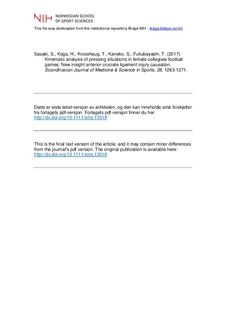| dc.contributor.author | Sasaki, Shogo | |
| dc.contributor.author | Koga, Hideyuki | |
| dc.contributor.author | Krosshaug, Tron | |
| dc.contributor.author | Kaneko, Satoshi | |
| dc.contributor.author | Fukubayashi, Toru | |
| dc.date.accessioned | 2018-12-13T12:46:09Z | |
| dc.date.available | 2018-12-13T12:46:09Z | |
| dc.date.created | 2018-01-16T13:04:07Z | |
| dc.date.issued | 2018 | |
| dc.identifier.citation | Scandinavian Journal of Medicine & Science in Sports. 2018, 28, 1263-1271. | nb_NO |
| dc.identifier.issn | 0905-7188 | |
| dc.identifier.uri | http://hdl.handle.net/11250/2577607 | |
| dc.description | I Brage finner du siste tekst-versjon av artikkelen, og den kan inneholde ubetydelige forskjeller fra forlagets pdf-versjon. Forlagets pdf-versjon finner du på onlinelibrary.wiley.com / In Brage you'll find the final text version of the article, and it may contain insignificant differences from the journal's pdf version. The definitive version is available at onlinelibrary.wiley.com | nb_NO |
| dc.description.abstract | The most common events during which anterior cruciate ligament (ACL) injuries occur in football are pressing situations. This study aimed to describe the knee and hip joint kinematics during pressing situations in football games to identify kinematic patterns in actions with a high risk for ACL injuries. We filmed 5 female collegiate football matches and identified 66 pressing situations. Five situations with a large distance between the trunk and foot placements in the sagittal plane were analyzed using a model-based image-matching technique. The mean knee flexion angle at initial contact (IC) was 13° (range, 8°-28°) and increased by 11° (95% confidence interval [CI], 3°-14°) at 40 ms after IC. As for knee adduction and rotation angles, the knee positions were close to neutral at IC, and only minor knee angular changes occurred later in the sequences. The mean hip flexion was 25° (range, 8°-43°) at IC and increased by 22° (95% CI, 11°-32°) after 100 ms. The hip was also externally rotated by 7° (range, −19° to 3°) at IC, and gradually rotated internally, reaching 10° of internal rotation (range, −5° to 27°) at 100 ms after IC. This study suggests that the observed knee valgus, internal hip and knee rotation, and static hip flexion previously reported in non-contact ACL injury events are unique to injury situations. In contrast, neither rapid knee valgus nor increased internal rotation was seen in non-injury pressing maneuvers. | nb_NO |
| dc.language.iso | eng | nb_NO |
| dc.subject | deceleration | nb_NO |
| dc.subject | defender | nb_NO |
| dc.subject | high risk maneuver | nb_NO |
| dc.subject | hip | nb_NO |
| dc.subject | knee | nb_NO |
| dc.subject | match situation | nb_NO |
| dc.subject | motion analysis | nb_NO |
| dc.title | Kinematic analysis of pressing situations in female collegiate football games: New insight into anterior cruciate ligament injury causation | nb_NO |
| dc.title.alternative | Kinematic analysis of pressing situations in female collegiate football games: New insight into anterior cruciate ligament injury causation | nb_NO |
| dc.type | Journal article | nb_NO |
| dc.type | Peer reviewed | nb_NO |
| dc.description.version | acceptedVersion | nb_NO |
| dc.source.pagenumber | 1263-1271 | nb_NO |
| dc.source.volume | 28 | nb_NO |
| dc.source.journal | Scandinavian Journal of Medicine & Science in Sports | nb_NO |
| dc.source.issue | 3 | nb_NO |
| dc.identifier.doi | 10.1111/sms.13018 | |
| dc.identifier.cristin | 1544107 | |
| dc.description.localcode | Seksjon for idrettsmedisinske fag / Department of Sports Medicine | nb_NO |
| cristin.unitcode | 150,34,0,0 | |
| cristin.unitname | Seksjon for idrettsmedisinske fag | |
| cristin.ispublished | true | |
| cristin.fulltext | postprint | |
| cristin.qualitycode | 2 | |
